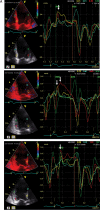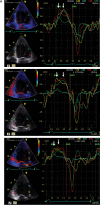Echocardiography, dyssynchrony, and the response to cardiac resynchronization therapy
- PMID: 20709721
- PMCID: PMC2948202
- DOI: 10.1093/eurheartj/ehq263
Echocardiography, dyssynchrony, and the response to cardiac resynchronization therapy
Abstract
Biventricular pacing or cardiac resynchronization therapy (CRT) has been a considerable advance in the therapy of chronic heart failure. However, it is clear that not all patients benefit either in terms of symptoms or cardiac function, and some may be worsened by CRT. In this review, we consider the arguments, both clinical and economical, in favour of improved selection of patients for CRT other than those in current guidelines. It also seems clear that the fundamental mechanism of CRT is correction of dyssynchrony, and we review the various methodologies available to detect dyssynchrony. Other factors are probably also important in determining outcomes such as lead position, the extent and form of myocardial damage, optimizing pacemaker performance, and clinical expertise. The potential costs of inappropriate CRT implantation are high to our patients and to the health economy, and it behooves the cardiology community to develop better selection criteria. The current guidelines can and should be improved.
Figures









Similar articles
-
Assessment of mechanical dyssynchrony in cardiac resynchronization therapy.Dan Med J. 2014 Dec;61(12):B4981. Dan Med J. 2014. PMID: 25441737 Review.
-
Cardiac Resynchronization Therapy in Patients With Heart Failure and Narrow QRS Complexes.J Am Coll Cardiol. 2018 Mar 27;71(12):1325-1333. doi: 10.1016/j.jacc.2018.01.042. J Am Coll Cardiol. 2018. PMID: 29566816 Clinical Trial.
-
Real time three-dimensional echocardiography in assessment of left ventricular dyssynchrony and cardiac resynchronization therapy.Echocardiography. 2012 Feb;29(2):192-9. doi: 10.1111/j.1540-8175.2011.01622.x. Echocardiography. 2012. PMID: 22283200 Review.
-
Echocardiography and cardiac resynchronization therapy in children and patients with congenital heart disease.Minerva Pediatr. 2012 Oct;64(5):451-60. Minerva Pediatr. 2012. PMID: 22992528 Review.
-
The impact of multipole pacing on left ventricular function in patients with cardiac resynchronization therapy - A real-time three-dimensional echocardiography approach.Int J Cardiol. 2018 Dec 1;272:238-243. doi: 10.1016/j.ijcard.2018.08.033. Epub 2018 Aug 15. Int J Cardiol. 2018. PMID: 30121181
Cited by
-
Echocardiography in the Diagnosis of Cardiomyopathies: Current Status and Future Directions.Rev Cardiovasc Med. 2022 Aug 10;23(8):280. doi: 10.31083/j.rcm2308280. eCollection 2022 Aug. Rev Cardiovasc Med. 2022. PMID: 39076629 Free PMC article. Review.
-
Response and outcomes of cardiac resynchronization therapy in patients with renal dysfunction.J Interv Card Electrophysiol. 2018 Apr;51(3):237-244. doi: 10.1007/s10840-018-0330-6. Epub 2018 Feb 19. J Interv Card Electrophysiol. 2018. PMID: 29460235
-
Electrically guided versus imaging-guided implant of the left ventricular lead in cardiac resynchronization therapy: a study protocol for a double-blinded randomized controlled clinical trial (ElectroCRT).Trials. 2018 Nov 1;19(1):600. doi: 10.1186/s13063-018-2930-y. Trials. 2018. PMID: 30382923 Free PMC article.
-
Integrative and quantitive evaluation of the efficacy of his bundle related pacing in comparison with conventional right ventricular pacing: a meta-analysis.BMC Cardiovasc Disord. 2017 Aug 11;17(1):221. doi: 10.1186/s12872-017-0649-4. BMC Cardiovasc Disord. 2017. PMID: 28800733 Free PMC article. Review.
-
Speckle tracking echocardiography analyses of myocardial contraction efficiency predict response for cardiac resynchronization therapy.Cardiovasc Ultrasound. 2018 Nov 19;16(1):30. doi: 10.1186/s12947-018-0148-5. Cardiovasc Ultrasound. 2018. PMID: 30453975 Free PMC article.
References
-
- McAlister FA, Ezekowitz JA, Wiebe N, Rowe B, Spooner C, Crumley E, Hartling L, Klassen T, Abraham W. Systematic review: cardiac resynchronization in patients with symptomatic heart failure. Ann Intern Med. 2004;141:381–390. - PubMed
-
- Fox M, Mealing S, Anderson R, Dean J, Stein K, Price A, Taylor RS. The clinical effectiveness and cost-effectiveness of cardiac resynchronisation (biventricular pacing) for heart failure: systematic review and economic model. Health Technol Assess. 2007;11:iii-248. - PubMed
-
- Chung ES, Leon AR, Tavazzi L, Sun JP, Nihoyannopoulos P, Merlino J, Abraham WT, Ghio S, Leclercq C, Bax JJ, Yu CM, Gorcsan J, III, St John SM, De Sutter J, Murillo J. Results of the Predictors of Response to CRT (PROSPECT) trial. Circulation. 2008;117:2608–2616. doi:10.1161/CIRCULATIONAHA.107.743120. - DOI - PubMed
-
- Hawkins NM, Petrie MC, Burgess MI, McMurray JJ. Selecting patients for cardiac resynchronization therapy: the fallacy of echocardiographic dyssynchrony. J Am Coll Cardiol. 2009;53:1944–1959. doi:10.1016/j.jacc.2008.11.062. - DOI - PubMed
-
- Sanderson JE. Echocardiography for cardiac resynchronization therapy selection: fatally flawed or misjudged? J Am Coll Cardiol. 2009;53:1960–1964. doi:10.1016/j.jacc.2008.12.071. - DOI - PubMed
Publication types
MeSH terms
Grants and funding
LinkOut - more resources
Full Text Sources
Medical
Research Materials

